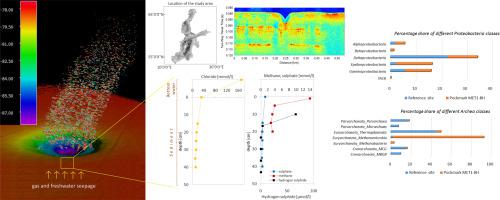Science of the Total Environment ( IF 8.2 ) Pub Date : 2020-06-18 , DOI: 10.1016/j.scitotenv.2020.140306 Jakub Idczak 1 , Aleksandra Brodecka-Goluch 1 , Katarzyna Łukawska-Matuszewska 1 , Bożena Graca 1 , Natalia Gorska 1 , Zygmunt Klusek 2 , Patryk D Pezacki 1 , Jerzy Bolałek 1

|
High-resolution bathymetric data were collected with a multi-beam echosounder in the southern part of the Baltic Sea (region MET1, Gulf of Gdańsk) revealing the presence of a 10 m deep and 50 m in diameter pockmark (MET1-BH) on the sea bottom (78.7 m). To date, no such structures have been observed to reach this size in the Baltic Sea. The salinity of the near-bottom water in the pockmark was about 2 PSU (about 31.22 mmol/l Cl−), which clearly indicated the presence of a submarine groundwater discharge (SGD). Water column, sediments and the seabed structure were investigated in the MET1-BH area using various hydroacoustic devices: multi-beam and splitbeam echosounders and a sub-bottom profiler. Geochemical analyses of sediment pore waters (CH4, Cl−, Br−, F−, SO42−, Ca2+, Mg2+, K+, Na+, ∑H2S, dP, dSi, NH4+, DIC, DOC) and microbiological analysis of sediments (16S rRNA) were performed. The content of CH4 and CO2 in the outflowing gas and its origin (δ13C-CH4 and δ2D-CH4) were determined. Hydroacoustic data showed that gas was emitted intensively from the inside of the structure. The height and intensity of the gas flares varied depending on the hydrostatic pressure. The gas contained 76.1% of CH4, 17.6% of CO2 and 0.39% of He. Methane source was microbial. Geophysical investigation revealed the presence of dislocations in sub-surface sediment layers in the MET1 region, which could have created a passage for groundwater and gas. Geochemical analyses pointed to intensive processes of organic matter decomposition in this area, active methanogenesis in the surface sediment layer, lack of the sulphate-methane transition, and freshwater seepage at a depth of ~88 m (bottom of the pockmark), probably from Upper Cretaceous deposits. The Prokaryota composition, atypical for marine surface sediments, resulted from the combination of freshwater and high organic matter content, and reflected active in situ methanogensis.
中文翻译:

地球物理,地球化学和微生物学研究,一个新发现的带有活性气体渗透和海底地下水排放的麻点(MET1-BH,格但斯克中部海湾,波罗的海南部)。
在波罗的海南部(格但斯克湾MET1区)用多波束回波测深仪收集了高分辨率测深数据,揭示了海面深10 m和直径50 m的麻子(MET1-BH)存在。海底(78.7 m)。迄今为止,在波罗的海还没有观察到达到这种规模的结构。在麻面的近底部水的盐度为约2 PSU(约31.22毫摩尔/升氯- ),这清楚地表示的海底地下水排放(SGD)的存在。在MET1-BH地区,使用多种水声装置对水柱,沉积物和海床结构进行了研究:多束和分束回波测深仪和下底剖面仪。沉积物孔隙水的地球化学分析(CH 4,氯- ,溴-,F -,SO 4 2-,钙2+,镁2+,K +,钠+,ΣH 2 S,DP,DSI,NH 4 +,DIC,DOC)和沉积物的微生物分析(的16S rRNA)被执行。CH的内容4和CO 2的流出的气体中和其来源(δ 13 C-CH 4和δ 2 d-CH 4)确定。水声数据表明,气体从结构内部大量排放。气体火炬的高度和强度取决于静水压力而变化。的气体含有CH的76.1%4,CO 17.6%2和He的0.39%甲烷来源是微生物。地球物理研究表明,MET1地区地下沉积物层中存在位错,这可能为地下水和天然气创造了通道。地球化学分析指出,该区域有机物分解的密集过程,表层沉积物层中的活跃甲烷生成,缺乏硫酸盐-甲烷过渡以及〜88 m深度(麻点的底部)的淡水渗漏,可能来自上层白垩纪沉积。原核生物的成分,非典型的海洋表层沉积物,是由于淡水和高有机质含量的结合而产生的,并反映出活跃的原位产甲烷作用。











































 京公网安备 11010802027423号
京公网安备 11010802027423号